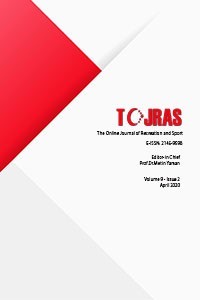ARE SHOULDER MOBILITY TEST SCORES RELATED TO THROWING PERFORMANCE OR ARE THEY AN INJURY SIGNAL? (A Functional Movement Screen Study In Young Track And Field Throwing Athletes)
ARE SHOULDER MOBILITY TEST SCORES RELATED TO THROWING PERFORMANCE OR ARE THEY AN INJURY SIGNAL? (A Functional Movement Screen Study In Young Track And Field Throwing Athletes)
Throws branch is a sport that has the risk of injury due to the movement patterns consisting of excessive repetitions and the need for explosive power production. For this reason, it is important for the athlete's sports career to be able to determine the injury risks beforehand and to take protective measures. This study was aimed to evaluate the functional movement scores of young athletes competing in throwing branches.
A total of 11 athletes (7 male and 4 female, aged 14-19), who participated in regional and national competitions and continued training regularly, were participated in the study. After analyzing the physical and anthropometric characteristics of the participants (height, body weight, body mass index and body composition parameters) Functional Movement Screen (FMS™) test measurements were applied.
Trunk stability push-up test had the lowest average score of 2.18 in the test. In male participants, hurdle step, in-line lunge, trunk stability push up shoulder mobility test results demonstrated that was asymmetry. Active straight leg raise and shoulder mobility test results in asymmetry results in female participants are remarkable. The functional movement screening test total score average was found to be 17 for both genders. Also non-significant correlations between shoulder mobility and overhead medicine ball throwing tests.
The results showed that shoulder mobility test scores cannot be used to predict throwing performance in young track and field thrower athletes. There is a need for studies with large participant groups evaluating both genders in sports that use repetitive movement patterns in future research.
Keywords:
Shoulder Mobility Injury Risk, Prevention, Adolescent Athletes, Throwers,
___
- Alonso, J. M., Edouard, P., Fischetto, G., Adams, B., Depiesse, F., & Mountjoy, M. (2012). Determination of future prevention strategies in elite track and field: Analysis of Daegu 2011 IAAF Championships injuries and illnesses surveillance. British Journal of Sports Medicine, 46(7), 505–514. https://doi.org/10.1136/bjsports-2012-091008
- Badura, M. (2010). Biomechanical analysis of the discus at the 2009 IAAF World Championships in athletics. New Studies in Athletics, 25(3/4), 23–35. file:///C:/PhD/Mdx/Articles/tech_Biomechanical Analysis Worlds 2009.pdf
- Bazyler, C. D., Mizuguchi, S., Harrison, A. P., Sato, K., Kavanaugh, A. A., Deweese, B. H., & Stone, M. H. (2017). Changes in muscle architecture, explosive ability, and track and field throwing performance throughout a competitive season and after a taper. Journal of Strength and Conditioning Research, 31(10), 2785–2793. https://doi.org/10.1519/JSC.0000000000001619
- Chorba, R. S., Chorba, D. J., Bouillon, L. E., Overmyer, C. A., & Landis, J. A. (2010). Use of a functional movement screening tool to determine injury risk in female collegiate athletes. North American Journal of Sports Physical Therapy : NAJSPT, 5(2), 47–54. http://www.ncbi.nlm.nih.gov/pubmed/21589661%0Ahttp://www.pubmedcentral.nih.gov/articlerender.fcgi?artid=PMC2953387
- Crouse, V. J. (2014). The functional movement screen and its relationship to measures of athletic-related performance, body composition and injury rates. May, 1–95. https://etda.libraries.psu.edu/paper/21560/22379
- Domaradzki, J., & Koźlenia, D. (2020). Reliability of functional movement screen and sexual differentiation in fms scores and the cut-off point among amateur athletes. Trends in Sport Sciences, 27(2), 87–92. https://doi.org/10.23829/TSS.2020.27.2-5
- Katie R. Hirsch, Abbie E. Smith-Ryan, Eric T. Trexler, E. J. R. (2016). Body Composition and Muscle Characteristics of Division I Track And Field Athletes. 30(5), 1231–1238.
- Lauersen, J. B., Andersen, T. E., & Andersen, L. B. (2018). Strength training as superior, dose-dependent and safe prevention of acute and overuse sports injuries: A systematic review, qualitative analysis and meta-analysis. British Journal of Sports Medicine, 52(24), 1557–1563. https://doi.org/10.1136/bjsports-2018-099078
- Li, J. (2021). Visual Analysis and Prediction of Teen Hammer Throw Athletes’ Performance Using Data Mining Techniques. ACM International Conference Proceeding Series, PartF16898. https://doi.org/10.1145/3448734.3450917
- Mohammed A. Miniato, & Prashanth Anand, M. V. (n.d.). Anatomy, Shoulder and Upper Limb, Shoulder.
- Monique Mokha, Yelizaveta Buluchevskaya, A. L. (2020). Running Biomechanics Improve Following An In-Season Intervention Program Based On Pre-Test Functional Movement Screen Scores In Collegiate Distance Runners. 8th International Society of Biomechanics in Sport Conference, 892–895.
- Nuanes, G. (2015). The Effect of Throwers Ten Program On Shoulder Mobility In Overhead-Throwing Athletes: Vol. II (Issue May).
- Paine, R. M., & Voight, M. (1993). The Role of The Scapula. Journal of Orthopaedic and Sports Physical Therapy, 18(1), 386–391. https://doi.org/10.2519/jospt.1993.18.1.386
- Terzis, G., Karampatsos, G., & Georgiadis, G. (2007). Neuromuscular Control and Performance in Shot-Put Athletes. Journal of Sports Medicine and Physical Fitness, 47(3), 284–290.
- Thomas A. Kyriazis, Gerasimos Terzis, Konstantinos Boudolos, A. G. G. (2009). Muscular Power, Neuromuscular Activation, and Performance In Shot Put Athletes At Preseason And At Competition Period. 23(6), 1773–1779.
- Zarei, M., Eshghi, S., & Hosseinzadeh, M. (2021). The effect of a shoulder injury prevention programme on proprioception and dynamic stability of young volleyball players; a randomized controlled trial. BMC Sports Science, Medicine and Rehabilitation, 13(1), 1–9. https://doi.org/10.1186/s13102-021-00300-5
- ISSN: 2146-9598
- Yayın Aralığı: Yılda 4 Sayı
- Başlangıç: 2012
- Yayıncı: METİN YAMAN
Sayıdaki Diğer Makaleler
Erdem UYLAS, Şengül POLAT, Şevval Buse ALSOY, Erkan GÜNAY
ÜNİVERSİTE ÖĞRENCİLERİNİN EGZERSİZ BAĞIMLILIK DÜZEYLERİNİN İNCELENMESİ
Yunus Emre ÇİNGÖZ, Muhammet MAVİBAŞ
Değerler Eğitimi Açısından Beden Eğitimi Ve Spor
REKREATİF AKTİVİTELERİN KADINLARDA SERBEST ZAMAN DOYUM VE ÖZ GÜVEN DÜZEYLERİNE ETKİSİ
